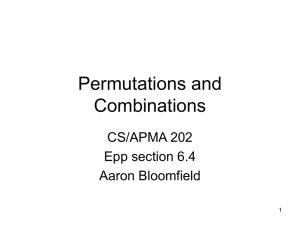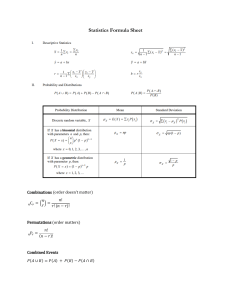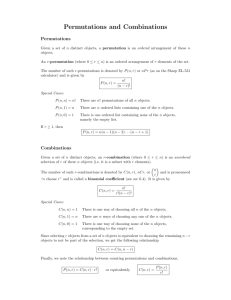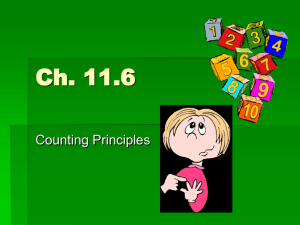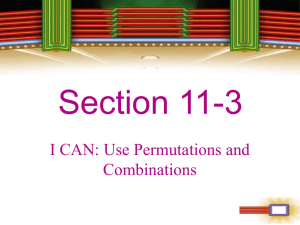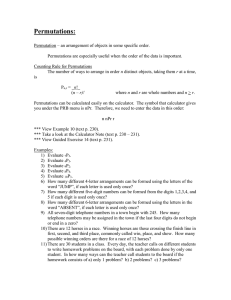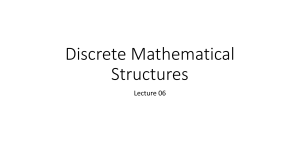Permutations and Combinations: A CS/APMA 202 Overview
advertisement
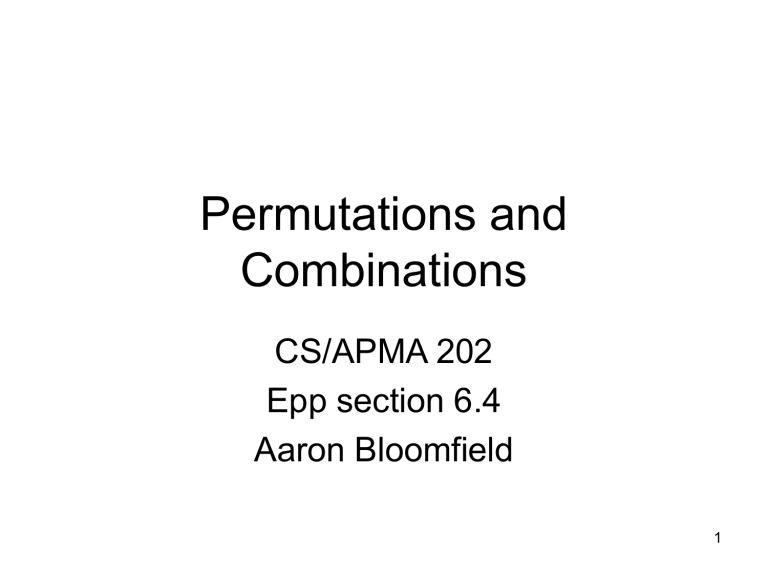
Permutations and
Combinations
CS/APMA 202
Epp section 6.4
Aaron Bloomfield
1
Permutations vs. Combinations
• Both are ways to count the possibilities
• The difference between them is whether order
matters or not
• Consider a poker hand:
– A♦, 5♥, 7♣, 10♠, K♠
• Is that the same hand as:
– K♠, 10♠, 7♣, 5♥, A♦
• Does the order the cards are handed out
matter?
– If yes, then we are dealing with permutations
– If no, then we are dealing with combinations
2
Permutations
• A permutation is an ordered arrangement of the
elements of some set S
– Let S = {a, b, c}
– c, b, a is a permutation of S
– b, c, a is a different permutation of S
• An r-permutation is an ordered arrangement of r
elements of the set
– A♦, 5♥, 7♣, 10♠, K♠ is a 5-permutation of the set of
cards
• The notation for the number of r-permutations:
P(n,r)
– The poker hand is one of P(52,5) permutations
3
Permutations
• Number of poker hands (5 cards):
– P(52,5) = 52*51*50*49*48 = 311,875,200
• Number of (initial) blackjack hands (2 cards):
– P(52,2) = 52*51 = 2,652
• r-permutation notation: P(n,r)
– The poker hand is one of P(52,5) permutations
P(n, r ) n(n 1)( n 2)...( n r 1)
n!
(n r )!
n
i
i n r 1
4
r-permutations example
• How many ways are there for 5 people in
this class to give presentations?
• There are 27 students in the class
– P(27,5) = 27*26*25*24*23 = 9,687,600
– Note that the order they go in does matter in
this example!
5
Permutation formula proof
• There are n ways to choose the first
element
– n-1 ways to choose the second
– n-2 ways to choose the third
–…
– n-r+1 ways to choose the rth element
• By the product rule, that gives us:
P(n,r) = n(n-1)(n-2)…(n-r+1)
6
Permutations vs. r-permutations
• r-permutations: Choosing an ordered 5
card hand is P(52,5)
– When people say “permutations”, they almost
always mean r-permutations
• But the name can refer to both
• Permutations: Choosing an order for all 52
cards is P(52,52) = 52!
– Thus, P(n,n) = n!
7
Sample question
• How many permutations of {a, b, c, d, e, f, g}
end with a?
– Note that the set has 7 elements
• The last character must be a
– The rest can be in any order
• Thus, we want a 6-permutation on the set {b, c,
d, e, f, g}
• P(6,6) = 6! = 720
• Why is it not P(7,6)?
8
Combinations
• What if order doesn’t matter?
• In poker, the following two hands are equivalent:
– A♦, 5♥, 7♣, 10♠, K♠
– K♠, 10♠, 7♣, 5♥, A♦
• The number of r-combinations of a set with n
elements, where n is non-negative and 0≤r≤n is:
n!
C (n, r )
r!(n r )!
10
Combinations example
• How many different poker hands are there
(5 cards)?
52!
52! 52 * 51* 50 * 49 * 48 * 47!
C (52,5)
2,598,960
5!(52 5)! 5!47!
5 * 4 * 3 * 2 *1* 47!
• How many different (initial) blackjack
hands are there?
52!
52! 52 * 51
C (52,2)
1,326
2!(52 2)! 2!50!
2 *1
11
Combination formula proof
• Let C(52,5) be the number of ways to generate
unordered poker hands
• The number of ordered poker hands is P(52,5) =
311,875,200
• The number of ways to order a single poker
hand is P(5,5) = 5! = 120
• The total number of unordered poker hands is
the total number of ordered hands divided by the
number of ways to order each hand
• Thus, C(52,5) = P(52,5)/P(5,5)
12
Combination formula proof
• Let C(n,r) be the number of ways to generate
unordered combinations
• The number of ordered combinations (i.e. rpermutations) is P(n,r)
• The number of ways to order a single one of
those r-permutations P(r,r)
• The total number of unordered combinations is
the total number of ordered combinations (i.e. rpermutations) divided by the number of ways to
order each combination
• Thus, C(n,r) = P(n,r)/P(r,r)
13
Combination formula proof
P(n, r ) n! /( n r )!
n!
C (n, r )
P(r , r ) r! /( r r )! r!(n r )!
14
Bit strings
• How many bit strings of length 10 contain:
a) exactly four 1’s?
Find the positions of the four 1’s
Does the order of these positions matter?
•
•
Nope!
Positions 2, 3, 5, 7 is the same as positions 7, 5, 3, 2
Thus, the answer is C(10,4) = 210
b) at most four 1’s?
There can be 0, 1, 2, 3, or 4 occurrences of 1
Thus, the answer is:
•
•
•
C(10,0) + C(10,1) + C(10,2) + C(10,3) + C(10,4)
= 1+10+45+120+210
= 386
15
Bit strings
• How many bit strings of length 10 contain:
c) at least four 1’s?
There can be 4, 5, 6, 7, 8, 9, or 10 occurrences of 1
Thus, the answer is:
•
•
•
C(10,4) + C(10,5) + C(10,6) + C(10,7) + C(10,8) + C(10,9)
+ C(10,10)
= 210+252+210+120+45+10+1
= 848
Alternative answer: subtract from 210 the number of
strings with 0, 1, 2, or 3 occurrences of 1
d) an equal number of 1’s and 0’s?
Thus, there must be five 0’s and five 1’s
Find the positions of the five 1’s
Thus, the answer is C(10,5) = 252
16
Corollary 1
• Let n and r be non-negative integers with
r ≤ n. Then C(n,r) = C(n,n-r)
• Proof:
n!
C (n, r )
r!(n r )!
n!
n!
C (n, n r )
(n r )!n (n r )! r!(n r )!
17
Corollary example
• There are C(52,5) ways to pick a 5-card poker
hand
• There are C(52,47) ways to pick a 47-card hand
• P(52,5) = 2,598,960 = P(52,47)
• When dealing 47 cards, you are picking 5 cards
to not deal
– As opposed to picking 5 card to deal
– Again, the order the cards are dealt in does matter
18
Combinatorial proof
• A combinatorial proof is a proof that uses counting
arguments to prove a theorem
– Rather than some other method such as algebraic techniques
• Essentially, show that both sides of the proof manage to
count the same objects
• Most of the questions in this section are phrased as,
“find out how many possibilities there are if …”
– Instead, we could phrase each question as a theorem:
– “Prove there are x possibilities if …”
– The same answer could be modified to be a combinatorial proof
to the theorem
19
Circular seatings
• How many ways are there to sit 6 people around a circular table,
where seatings are considered to be the same if they can be
obtained from each other by rotating the table?
• First, place the first person in the north-most chair
– Only one possibility
• Then place the other 5 people
– There are P(5,5) = 5! = 120 ways to do that
• By the product rule, we get 1*120 =120
•
•
•
•
Alternative means to answer this:
There are P(6,6)=720 ways to seat the 6 people around the table
For each seating, there are 6 “rotations” of the seating
Thus, the final answer is 720/6 = 120
20
Horse races
• How many ways are there for 4 horses to finish if ties are allowed?
– Note that order does matter!
• Solution by cases
– No ties
• The number of permutations is P(4,4) = 4! = 24
– Two horses tie
• There are C(4,2) = 6 ways to choose the two horses that tie
• There are P(3,3) = 6 ways for the “groups” to finish
– A “group” is either a single horse or the two tying horses
• By the product rule, there are 6*6 = 36 possibilities for this case
– Two groups of two horses tie
• There are C(4,2) = 6 ways to choose the two winning horses
• The other two horses tie for second place
– Three horses tie with each other
• There are C(4,3) = 4 ways to choose the two horses that tie
• There are P(2,2) = 2 ways for the “groups” to finish
• By the product rule, there are 4*2 = 8 possibilities for this case
– All four horses tie
• There is only one combination for this
– By the sum rule, the total is 24+36+6+8+1 = 75
21
A last note on combinations
• An alternative (and more common) way to
denote an r-combination:
n
C (n, r )
r
• I’ll use C(n,r) whenever possible, as it is
easier to write in PowerPoint
22
